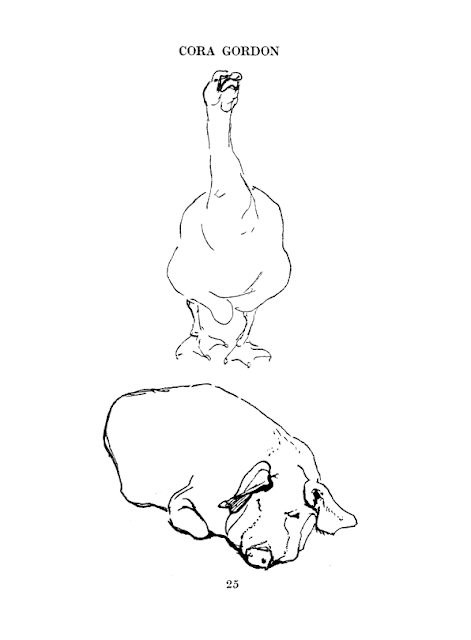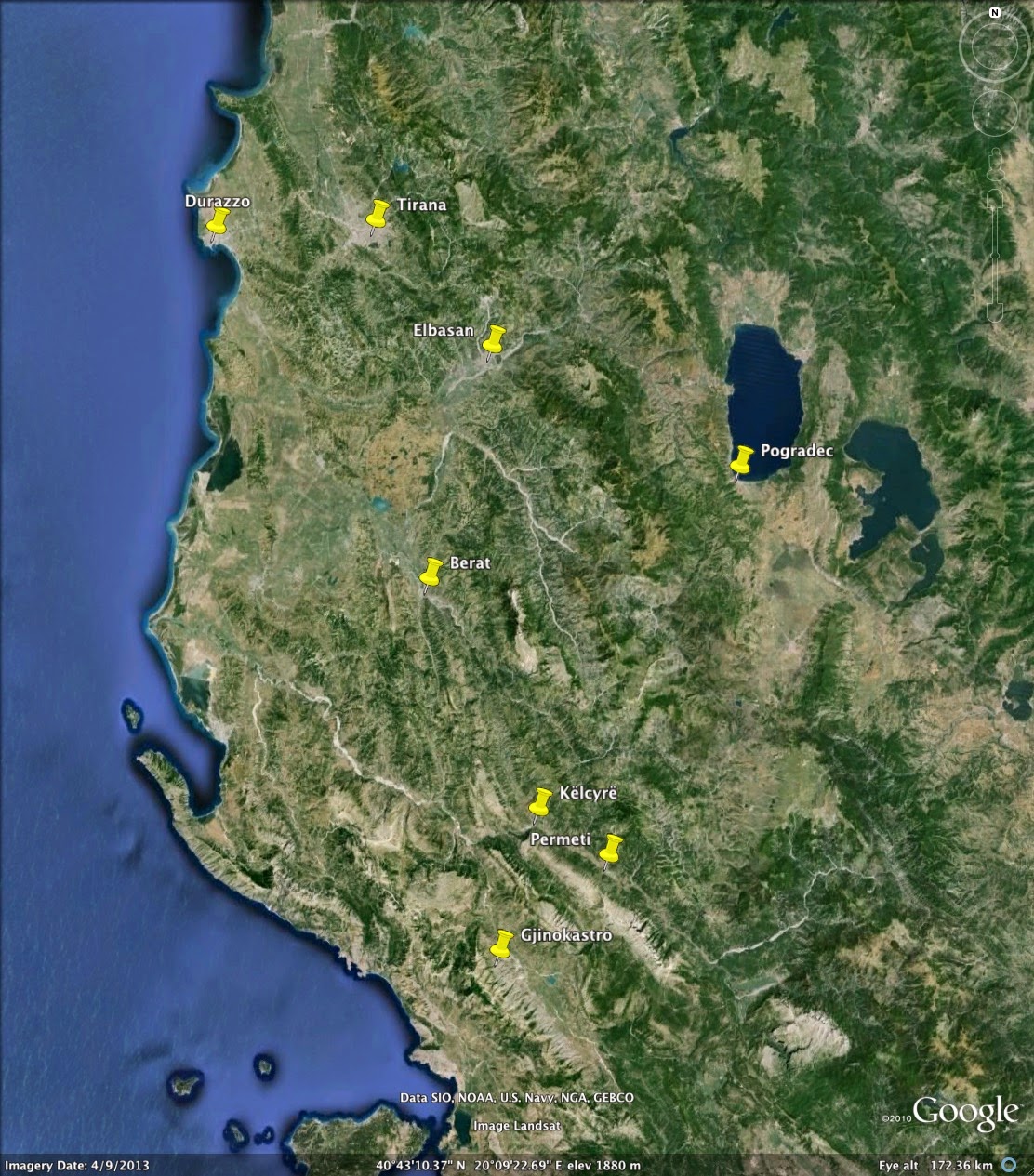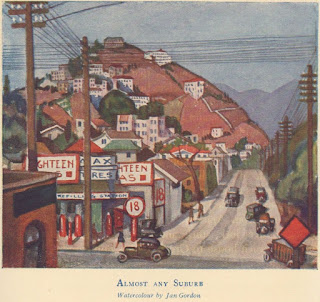A 1934 Exhibition by Jan and Cora Gordon in the Coventry Opera House Vestibule
An article in the Coventry Evening Telegraph, Tuesday 11 December 1934 (which I had not come across before), has the following title:
"JAN AND CORA GORDON Exhibition of Artistic Works DISPLAY IN COVENTRY OPERA HOUSE VESTIBULE"
The article mixes accounts of the art exhibition, Cora Gordon's talk on Sketching Through Europe" and various biographical anecdotes.
"Considerable interest is already being shown in the exhibition of artistic works by Jan and Cora Gordon in the vestibule of the Coventry Opera House this week It will be recalled that both artists are among those who have addressed Coventry Repertory Circle. Both are art critics to leading national papers as well as being artists themselves, and are also well known for their travel books. Jan Gordon is in hospital, where he is making a good recovery from a serious illness.
Jan and Cora Gordon are travellers in the true sense of the word. Wherever they have been they have been concerned less with pondering architectural and historical matters than with getting a real inside view of the lives and natures of the peoples of the countries and localities they have visited. This spirit is reflected in the wide selection of their works now on view at the Opera House. The majority of these works were among those shown at the Lefevre Gallery, London, at an exhibition which ended a fortnight ago. The works include oil paintings, drawings, illustrations. paintings in egg tempera, and etchings."
THE GREAT SERBIAN RETREAT
"Jan and Cora Gordon were studying in Paris when the War broke out, and upon arrival in England, after meeting all their obligations, found themselves left with £4 10s. With great optimism for the future, they furnished a flat on that! Trouble with an eye prevented Jan Gordon from being accepted for active service, but he and Mrs. Gordon were commissioned to go to a Serbian hospital at Vrnjachka Banja to give their services.
Their artistic inclination led them to explore the neighbouring mountains pretty thoroughly for subjects for their art. When the great Serbian retreat began in 1915. Jan Gordon was able to devise a route to safety through the mountains which proved shorter and safer than any other plan followed. The party of which the Gordons were in charge reached safety in five weeks. The next party to reach safety took nine Weeks, while one—in which most of those over forty years of age died - took three months.
When camouflaging of ships had been invented, Jan Gordon became chief designer in this important work. Although not of the Cubist school themselves, Jan and Cora Gordon had seen much of the work of cubists in Paris, and Jan was able to turn it to good and valuable account in the disguise of ships."
"While in Serbia, the Gordons had sent long letters home. When they returned home, it was these which led to their introduction to a firm of publishers and the production of their first book, "The Lucky Thirteen." Cora Gordon said their art made it possible for them to go to places ordinarily regarded by travellers as dull and uninteresting for its practice gave them something to do. It was much easier to get a real insight into the character of the people of a country by going to such places because there they were not on the look-out for foreign tourists to exploit. Their art helped their travel I books, and the latter helped their art. The Gordons hold the view that an artist should not confine him or herself to any particular branch, but be prepared to tackle anything. They have always made a point of obtaining a good working knowledge of the countries they have visited, finding that, by so doing, their purpose of getting to close quarters with the real nature of the people has been made easier."
"SKETCHING THROUGH EUROPE"
"Cora Gordon's Talk to Coventry Addressing members of the Coventry and Warwickshire Society of Artists in the Mayoress'e Parlour, St. Mary's Hall. Coventry, last night on "Sketching Through Europe," Mrs. Cora Gordon recounted some of the experiences of herself and her husband when carrying on their artistic work on their travels. Most artists could look back to some strange incident as having finally carried them round the corner and set them on the course of art. In her case it was the very strange one of winning a blot competition in a well-known women's periodical! As the result of winning that competition. her father allowed her to go to the Slade."
INSIGHT INTO VILLAGE LIFE
"Mrs. Gordon said her first job came while she was still a student. It was a commission to provide eleven pictures, for which she was to receive £5, for a lecturer to illustrate his stories with. They were to illustrate the story of a monk who had nothing to offer to God but his acrobatics, and who died in the course of his offering of gambolling in church. She began the pictures while in the Tyrol, and was promptly regarded as a holy woman in consequence of the nature of the pictures. The people made pilgrimages from the surrounding Tyrolean villages to see her. They were paraded into the bedroom where she worked by the landlady, but, although they looked at her sketching and talked to her husband in hushed voices, they never spoke to her, so awed were they of her.
Her sketching enabled her and her husband to travel through Albania without difficulty. While in Albania she had an armed soldier standing by her side while she sketched to prevent people getting in front of her. The women of Albania pestered her so much as to the reasons why they had no children that she at least decided to tell them they had had a son, but he had died. To her amazement they made a great fuss at this. It transpired she had used the wrong one of two similar words—one meaning "dead" and the other "burned to death." They thought she meant her "son" had been burned to death, hence their demonstration."
THE DRUNKEN PIGS
"In England, while on a visit in the country, her host's beer went sour. He gave it to a neighbouring farmer's pigs. It made them drunk, and she got numerous sketches of their intensely amusing behaviour and appearance. Mrs. Gordon said she did a great deal of her sketching with a fountain pen. She used this successfully in making surreptitious sketches in Lapland, where the peasantry, having been converted, regarded it as a sin to allow themselves to be drawn."
References
- Jan Gordon and the Dazzle-Painting of Ships. March 25, 2014.
- Jan and Cora Gordon in Albania. December 25, 2014.
- Jan and Cora Gordon and the Balkan Hat: Getting Published in World War I. May 09, 2014.
- Jan and Cora Gordon: "Wanderings and Flight in the Land of Mud". June 15, 2014.
- Jan Gordon on "Father Berry" in WW1 Serbia. February 23, 2015.
- Jan Gordon and The Coventry Repertory Company present "Piping George", 1934. March 08, 2015.
- Cora Gordon on "The Artist as a Traveller" 1950. March 15, 2015.
- Cora Gordon on "With a Ruc-sac Through Europe" at the Hull Young People's Institute, 1935. April 10, 2015.
- Artworks by Godfrey Jervis Gordon. June 29, 2015.
- Jan and Cora Gordon and the Chestertons, 100 years ago today. January 01, 2016.
- The return of the Gordons (100 years ago today). January 14, 2016.
- Jan Gordon on Albania, in The New Witness, January 1916. January 15, 2016.
- A Cora Josephine Gordon lecture in 1947: "Off the beaten Track in Europe". June 26, 2017.
"JAN AND CORA GORDON Exhibition of Artistic Works DISPLAY IN COVENTRY OPERA HOUSE VESTIBULE"
The article mixes accounts of the art exhibition, Cora Gordon's talk on Sketching Through Europe" and various biographical anecdotes.
"Considerable interest is already being shown in the exhibition of artistic works by Jan and Cora Gordon in the vestibule of the Coventry Opera House this week It will be recalled that both artists are among those who have addressed Coventry Repertory Circle. Both are art critics to leading national papers as well as being artists themselves, and are also well known for their travel books. Jan Gordon is in hospital, where he is making a good recovery from a serious illness.
Jan and Cora Gordon are travellers in the true sense of the word. Wherever they have been they have been concerned less with pondering architectural and historical matters than with getting a real inside view of the lives and natures of the peoples of the countries and localities they have visited. This spirit is reflected in the wide selection of their works now on view at the Opera House. The majority of these works were among those shown at the Lefevre Gallery, London, at an exhibition which ended a fortnight ago. The works include oil paintings, drawings, illustrations. paintings in egg tempera, and etchings."
THE GREAT SERBIAN RETREAT
"Jan and Cora Gordon were studying in Paris when the War broke out, and upon arrival in England, after meeting all their obligations, found themselves left with £4 10s. With great optimism for the future, they furnished a flat on that! Trouble with an eye prevented Jan Gordon from being accepted for active service, but he and Mrs. Gordon were commissioned to go to a Serbian hospital at Vrnjachka Banja to give their services.
Their artistic inclination led them to explore the neighbouring mountains pretty thoroughly for subjects for their art. When the great Serbian retreat began in 1915. Jan Gordon was able to devise a route to safety through the mountains which proved shorter and safer than any other plan followed. The party of which the Gordons were in charge reached safety in five weeks. The next party to reach safety took nine Weeks, while one—in which most of those over forty years of age died - took three months.
When camouflaging of ships had been invented, Jan Gordon became chief designer in this important work. Although not of the Cubist school themselves, Jan and Cora Gordon had seen much of the work of cubists in Paris, and Jan was able to turn it to good and valuable account in the disguise of ships."
"While in Serbia, the Gordons had sent long letters home. When they returned home, it was these which led to their introduction to a firm of publishers and the production of their first book, "The Lucky Thirteen." Cora Gordon said their art made it possible for them to go to places ordinarily regarded by travellers as dull and uninteresting for its practice gave them something to do. It was much easier to get a real insight into the character of the people of a country by going to such places because there they were not on the look-out for foreign tourists to exploit. Their art helped their travel I books, and the latter helped their art. The Gordons hold the view that an artist should not confine him or herself to any particular branch, but be prepared to tackle anything. They have always made a point of obtaining a good working knowledge of the countries they have visited, finding that, by so doing, their purpose of getting to close quarters with the real nature of the people has been made easier."
"SKETCHING THROUGH EUROPE"
"Cora Gordon's Talk to Coventry Addressing members of the Coventry and Warwickshire Society of Artists in the Mayoress'e Parlour, St. Mary's Hall. Coventry, last night on "Sketching Through Europe," Mrs. Cora Gordon recounted some of the experiences of herself and her husband when carrying on their artistic work on their travels. Most artists could look back to some strange incident as having finally carried them round the corner and set them on the course of art. In her case it was the very strange one of winning a blot competition in a well-known women's periodical! As the result of winning that competition. her father allowed her to go to the Slade."
INSIGHT INTO VILLAGE LIFE
"Mrs. Gordon said her first job came while she was still a student. It was a commission to provide eleven pictures, for which she was to receive £5, for a lecturer to illustrate his stories with. They were to illustrate the story of a monk who had nothing to offer to God but his acrobatics, and who died in the course of his offering of gambolling in church. She began the pictures while in the Tyrol, and was promptly regarded as a holy woman in consequence of the nature of the pictures. The people made pilgrimages from the surrounding Tyrolean villages to see her. They were paraded into the bedroom where she worked by the landlady, but, although they looked at her sketching and talked to her husband in hushed voices, they never spoke to her, so awed were they of her.
Her sketching enabled her and her husband to travel through Albania without difficulty. While in Albania she had an armed soldier standing by her side while she sketched to prevent people getting in front of her. The women of Albania pestered her so much as to the reasons why they had no children that she at least decided to tell them they had had a son, but he had died. To her amazement they made a great fuss at this. It transpired she had used the wrong one of two similar words—one meaning "dead" and the other "burned to death." They thought she meant her "son" had been burned to death, hence their demonstration."
THE DRUNKEN PIGS
"In England, while on a visit in the country, her host's beer went sour. He gave it to a neighbouring farmer's pigs. It made them drunk, and she got numerous sketches of their intensely amusing behaviour and appearance. Mrs. Gordon said she did a great deal of her sketching with a fountain pen. She used this successfully in making surreptitious sketches in Lapland, where the peasantry, having been converted, regarded it as a sin to allow themselves to be drawn."
References
- Jan Gordon and the Dazzle-Painting of Ships. March 25, 2014.
- Jan and Cora Gordon in Albania. December 25, 2014.
- Jan and Cora Gordon and the Balkan Hat: Getting Published in World War I. May 09, 2014.
- Jan and Cora Gordon: "Wanderings and Flight in the Land of Mud". June 15, 2014.
- Jan Gordon on "Father Berry" in WW1 Serbia. February 23, 2015.
- Jan Gordon and The Coventry Repertory Company present "Piping George", 1934. March 08, 2015.
- Cora Gordon on "The Artist as a Traveller" 1950. March 15, 2015.
- Cora Gordon on "With a Ruc-sac Through Europe" at the Hull Young People's Institute, 1935. April 10, 2015.
- Artworks by Godfrey Jervis Gordon. June 29, 2015.
- Jan and Cora Gordon and the Chestertons, 100 years ago today. January 01, 2016.
- The return of the Gordons (100 years ago today). January 14, 2016.
- Jan Gordon on Albania, in The New Witness, January 1916. January 15, 2016.
- A Cora Josephine Gordon lecture in 1947: "Off the beaten Track in Europe". June 26, 2017.




Comments
Post a Comment